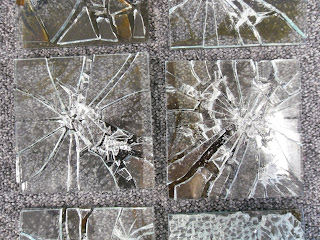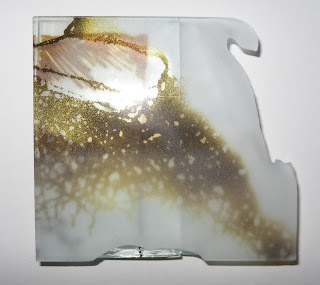So as I was making good progress with my wall design, it was advised to me to continue pushing and experimenting, as there was still another 8 weeks or so left on this brief, and it would be a shame just to stop at a certain point in order to make an installation piece consisting of ultimately the same thing repeated.
Therefore, the wall design was put on hold while I continued to experiment.
The next stage I felt I needed to look into was to make the bricks individual free-standing sculptures somehow, rather than flat panels. In order to do this however, I needed more layers to add a more stable base.
Below is my first try at taking one of the bricks and adding to it to make a more sculptural piece. The initial brick had actually been cut down:
Close Up:
I had wanted the top layers to look like a representation of peeling paint or plaster from a derelict wall, and I had started this experimentation by sandblasting deeply all the way through a piece of glass to get the rough 'eroded' looking edge, and then the pieces were put into the kiln and slumped over cat litter (!) to get the 'bubbling' texture.
I do like the effect it is having, but I think there is room for further development here. A good first try though I feel :)
Try #2:
I am so much happier with this piece. Again, I have recycled one of my single-layer bricks to produce this, and I feel like it works really well in terms of composition. I am naturally drawn to long vertical panel shapes anyway, as well as a sepia colour scheme which will always catch my eye!
Close Ups:
Again, I have used another piece which had been slumped over cat litter and I particularly like the deeply sandblasted areas as well as the lightly sandblasted areas where the sketchiness of the screen-print is still visible.
Still needs to be more three-dimensional in order for it to be free-standing, but at least they are becoming more sculptural now.
Other attempts:
I came across a couple of jewellers that worked to similar themes as me, in particular Kirsty Sumerling, and it made me think about trying to create areas of negative space within the pieces, to add areas of contrast.
The only was I could think to do this initially was to introduce metal 'frame'-type elements, and I cut some shapes out of copper, brass and gilding metal in order to try it.
I did not want a conventional frame shape, and instead opted for a variety of differing sides.
Here I am trying to figure out composition and whether the metal adds to the piece at all:
I am glad I have tried this, and I do feel it works nicely in certain parts of certain pieces, but it is not something I am going to pursue, and I am going to continue experimenting further.













































































